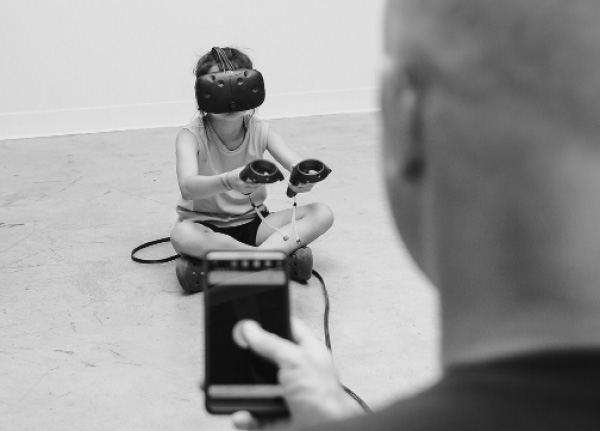
VIRTUAL REALITIES
first performed on September 12, 2017
Morlan Gallery, Transylvania University, Lexington, KY
performed twice in 2017
THE CONTROLLERS
(RICHIE HOAGLAND / DMITRY "DIMA" STRAKOVSKY)
Lexington, KY
727249562t727249562h727249562e727249562.727249562c727249562o727249562n727249562t727249562r727249562o727249562l727249562l727249562e727249562r727249562s727249562.727249562g727249562r727249562o727249562u727249562p727249562@727249562g727249562m727249562a727249562i727249562l727249562.727249562c727249562o727249562m
medium.com/the-controllers
VIRTUAL REALITIES
THE CONTROLLERS
Our interpersonal communication channels, even among close family members, are increasingly filtered through various layers of mediating technologies. Texting, various messaging apps, hardware devices, and now VR and AR, all shape our communication patterns. These technologies force changes that are both organic and jarring: extending our desires for fluid communication with, and instant feedback from, larger audiences, yet simultaneously warping our traditional notions of both privacy and intimacy.
We wanted to address these issues directly, in a way that truly signaled our own ambivalences, so Dima invited his kids to collaborate in the creation process. We play-tested the software multiple times and adjusted it based on kids’ feedback to truly make it enjoyable to play live.
The performance of “Virtual Realities” took on the characteristics of a sales demo in which Dima and his kids demonstrated the “revolutionary software” that improved on the age old patterns of parent-child interaction. Richie took on the role of the VR Experience Designer and narrated the fictional pitch. The demos included a virtual ball game in which Dima was using his phone to trigger a ball roll in the VR to one of his children, a virtual xylophone, similarly controlled by him, and a game of tag in which the parent was in the physical world and the child in the virtual one. These were based on the simple play scenarios with analogs in the physical world. The child’s view from within the VR environment was projected for the audience to see and after the completion of the performances, the audience members were invited to play themselves.
We tried to balance the seductive elements of the technologies that we engaged with and the imagery that clearly problematizes the supposed “technological progress.” The imagery of a child’s body covered with VR equipment while a parent stares intently at their mobile device created an uncomfortable, if not downright disturbing, experience for the viewers. Based on the subsequent conversations, we can say that for many people in the audience it was really hard to reconcile our critical approach with the fact that the children were genuinely laughing and having fun. We believe that this is precisely what casts the work as an interesting open-ended question.